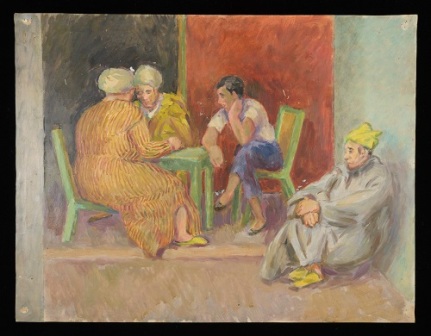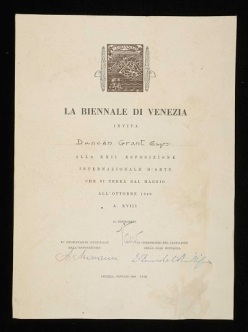Apollo in his Temple
CHA-P-1240 Recto. Duncan Grant, drawing, Women at Work, ink on lined paper. Photograph © The Charleston Trust
In February 1910 Duncan Grant was invited by Maynard Keynes to join him on a visit to Greece and Asia Minor. While their physical relationship was over by this time, as detailed in an earlier blog post here, the couple remained close friends and continued to travel abroad together, their trips often funded by Keynes. These excursions provided an ideal opportunity for Grant to visit galleries and heritage sites, and to paint and draw local landscapes and people. The creative results of his observations are captured in numerous sketchbooks and upon loose sheets of paper found within the Angelica Garnett Gift.
A particularly interesting token of the 1910 trip was recently uncovered; a thin sheet of lined writing paper upon which a hastily-drawn group of women in long robes and headscarves has been sketched. Like many of the loose works in the Gift this object has dual status, as upon turning the page we discover that Grant has sketched the scene on the back of a letter sent to Keynes by the Compagnie Messageries Meritimes confirming his booking for the Paquebot Senegal, the boat that would take the two friends from Piraeus to Troy on the 12th April, 1910. Although the drawing could have been made later than this (as detailed on the blog previously, Grant often kept materials to use at a later date) it is quite likely that Grant made the drawing during this trip with Keynes.
Frances Spalding, Duncan Grant’s biographer, describes the pair’s journey:
Duncan and Maynard left London on 17th March 1910 and were away for seven weeks in all. They travelled by boat from Marseilles to Athens, and on arrival found a hotel that faced the Acropolis. In Athens they employed a dragoman to accompany them on a journey by horse through the Pelopommese. They travelled through mountain villages to Bassae, carrying food supplies with them. It was a memorable trip. ‘I must tell you about Greece when I see you,’ Duncan wrote to Lytton. ‘It is a divine country…but the remains of ancient Greece. Oh! how melancholy they make one.’
While at Bassae Keynes photographed Grant posing nude, in the guise of a Greek god: ‘I developed Apollo in his temple at Bassae yesterday and printed him to-day,’ Maynard told Duncan. ‘He is lovely…It will be quite unnecessary to take in the Sportszeitung anymore.’
CHA-P-1240-Verso. Letter to Maynard Keynes confirming tickets for the Paquebot Senegal, 10th April, 1910. Photograph © The Charleston Trust
Spalding continues:
They moved on to Turkey, travelling on the Paquebot Senegal, stopping at Troy where they stayed with an English couple who owned a farm on the banks of the Skemander. At St Smyrna they were both much taken with the exotic colours and noises of the bazaar. However, Duncan was disappointed with Constantinople, finding it too large and its narrow streets filthy, though he thought the Hagia Sophia one of the most impressive buildings he had ever seen. He felt much happier at Brusa, the ancient Ottoman capital, with its magnificent mosques, tall minarets, cypresses and hot spring baths, situated amid beautiful scenery overlooked by Mount Olympus. One of the most significant experiences of all was the opportunity to familiarise himself with Byzantine mosaics.
Later the same year Roger Fry’s First Post-Impressionist Exhibition opened at the Grafton Galleries to much excitement and controversy. The show would have a deep and lasting impact not only on Grant and other members of the Bloomsbury group, but also the wider art world and gallery-going public. Grant’s work of 1911 to 1912 reveals the impact of the Post-Impressionists, but also of his discovery of Byzantine mosaics and romanesque decoration seen on excursions abroad such as the 1910 trip with Keynes.
Duncan Grant, On the Roof, 38 Brunswick Square, oil on canvas, 1912
His painting titled On the Roof, 38 Brunswick Square made in 1912 has been seen to combine such sources. Depicting Virginia Stephen, Adrian Stephen and Leonard Woolf relaxing on the mezzanine roof at the back of the large eighteenth century house shared by the Stephen siblings and their friends, the painting’s pointillist brushwork, flat picture plane and mosaic-like patches of colour present an amalgamation of the cultural, historical and artistic sources influencing the artist at this time.
CHA/P/185 Vase, circa 1911, ceramic, decorated by Duncan Grant, made in Tunis, North Africa, 34 cm x 20 cm x 20 cm. Photograph © The Charleston Trust
Such influences are also reflected in a number of Grant’s decorative works made during this period, an example being a vase purchased and decorated by Grant in Tunis during a trip in 1911 and displayed in the Studio at Charleston. This vase combines both the influence of Post-Impressionist design with its calligraphic nude (Grant was particularly impressed by Henri Matisse’s ceramic works shown at Fry’s 1910 exhibition), and the utilitarian form of traditional Tunisian earthenware.
CHA-P-1773. Duncan Grant, painting, Men in Turkey. Photograph © The Charleston Trust
Grant continued to travel and paint abroad, even in his old age. This large painting, found in the Angelica Garnett Gift, depicts a scene witnessed by Grant during a trip to southern Turkey with his close friend Paul Roche in 1973.
In addition to its role as a biographical object, the letter sent to Maynard Keynes is interesting for its inclusion in the Angelica Garnett Gift in the first place. The 8000 items that make up the archive all originated at Charleston and were only taken into storage after Grant died in the 1970s. The artists did not move to Charleston until 1916, therefore this letter and its accompanying drawing had been kept by Grant and moved to the house amongst all manner of personal affects years after it was first received by Keynes in Athens during his trip with Grant in 1910.






 Eveline with a painting by Vanessa Bell from the Angelica Garnett Gift. Photograph © The Charleston Trust
Eveline with a painting by Vanessa Bell from the Angelica Garnett Gift. Photograph © The Charleston Trust


